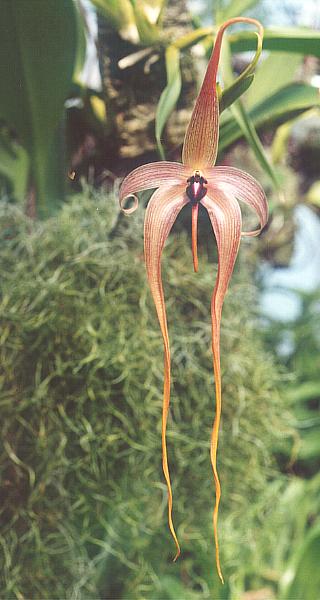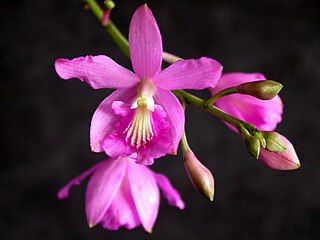
Orchids are plants that belong to the family Orchidaceae, a diverse and widespread group of flowering plants with blooms that are often colourful and fragrant.

Bulbophyllum is a genus of mostly epiphytic and lithophytic orchids in the family Orchidaceae. It is the largest genus in the orchid family and one of the largest genera of flowering plants with more than 2,000 species, exceeded in number only by Astragalus. These orchids are found in diverse habitats throughout most of the warmer parts of the world including Africa, southern Asia, Latin America, the West Indies, and various islands in the Indian and Pacific Oceans. Orchids in this genus have thread-like or fibrous roots that creep over the surface of trees or rocks or hang from branches. The stem is divided into a rhizome and a pseudobulb, a feature that distinguished this genus from Dendrobium. There is usually only a single leaf at the top of the pseudobulb and from one to many flowers are arranged along an unbranched flowering stem that arises from the base of the pseudobulb. Several attempts have been made to separate Bulbophyllum into smaller genera, but most have not been accepted by the World Checklist of Selected Plant Families.

The pseudobulb is a storage organ found in many epiphytic and terrestrial sympodial orchids. It is derived from a thickening of the part of a stem between leaf nodes and may be composed of just one internode or several, termed heteroblastic and homoblastic respectively. All leaves and inflorescences usually arise from this structure. Pseudobulbs formed from a single internode produce the leaves and inflorescence from the top, while those that are formed from several internodes can possess leaves along its length. The modified sheath leaves that appear at the base of a pseudobulb and often enfold all or part of it are usually dry and papery, though in some orchids the sheaths bear leaf blades and the leaves at the pseudobulb's apex are reduced to scales.

Zygopetalum is a genus of the orchid family (Orchidaceae), consisting of fourteen currently recognized species.

Gongora, abbreviated Gga in horticultural trade, is a member of the orchid family (Orchidaceae). It consists of 65 species known from Central America, Trinidad, and tropical South America, with most species found in Colombia. They grow across a wide geographical range, from wet forests at sea level, to mountainous regions in the Andes, as high as 1,800 m.

Cymbidium, commonly known as boat orchids, is a genus of evergreen flowering plants in the orchid family Orchidaceae. Orchids in this genus are epiphytic, lithophytic, terrestrial or rarely leafless saprophytic herbs usually with pseudobulbs. There are usually between three and twelve leaves arranged in two ranks on each pseudobulb or shoot and lasting for several years. From one to a large number of flowers are arranged on an unbranched flowering stem arising from the base of the pseudobulb. The sepals and petals are all free from and similar to each other. The labellum is significantly different from the other petals and the sepals and has three lobes. There are about fifty-five species and sixteen further natural hybrids occurring in the wild from tropical and subtropical Asia to Australia. Cymbidiums are well known in horticulture and many cultivars have been developed.

Grammatophyllum, sometimes abbreviated in horticultural trade as Gram, is a genus of 13 currently known orchid species. The name is derived from the Greek words 'gramma' and 'phyllon' (leaf), referring to the parallel leaf veins or the markings of the perianth. This epiphytic genus occurs in dense rainforest from Indo-China, to Indonesia, the Philippines, New Guinea, and the Southwest Pacific islands.

Anguloa, commonly known as tulip orchids, is a small orchid genus closely related to Lycaste. Its abbreviation in horticulture is Ang. This genus was described by José Antonio Pavón and Hipólito Ruiz López in 1798. They named it in honor of Francisco de Angulo, Director-General of Mines of Spain.

Ancistrochilus is a genus of the orchid family (Orchidaceae), comprising only 2 species.

Ansellia is considered a monotypic genus of orchid, with only one species, Ansellia africana, commonly known as African ansellia or leopard orchid, however, it may in fact be a complex group of species which share common floral structure and growth habit.

Maxillaria, abbreviated as Max in the horticultural trade, is a large genus of orchids. This is a diverse genus, with very different morphological forms. Their characteristics can vary widely. They are commonly called spider orchids, flame orchids or tiger orchids. Their scientific name is derived from the Latin word maxilla, meaning jawbone, reflecting on the column and the base of the lip of some species, that may evoke a protruding jaw.

Encyclia is a genus of orchids. The genus name comes from Greek enkykleomai, referring to the lateral lobes of the lip which encircle the column. It is abbreviated as E. in the horticultural trade.

Pseudolaelia is a small genus belonging to the orchid family (Orchidaceae), the entire genus endemic to Brazil. The abbreviation used in the horticultural trade is Pdla.

Lycaste, abbreviated as Lyc. in horticultural trade, is a genus of orchids that contains about 30 species with egg-shaped pseudobulbs and thin, plicate (pleated) leaves.

Dendrobium kingianum, commonly known as the pink rock orchid, is a flowering plant in the orchid family Orchidaceae and is endemic to eastern Australia. It usually grows on rocks, rarely as an epiphyte, and has thin, spreading leaves and spikes of up to fifteen, usually pink flowers in late winter to spring. It is popular in Australian native horticulture and is a commonly cultivated orchid among Australian orchid species growers.

Psychopsis is a genus of four known species of orchids native to northern South America, Central America and Trinidad. The genus name is abbreviated Pyp. in the horticultural trade.

Acriopsis emarginata, commonly known as the pale chandelier orchid, is a species of orchid endemic to Queensland. It is a clump-forming epiphyte with dark green leaves and curved, branching flower stems with many white and cream-coloured flowers.
Bulbophyllum minutissimum, commonly known as the red bead orchid or grain-of-wheat orchid, is a species of epiphytic or lithophytic orchid with small, flattened, reddish or green pseudobulbs, scale-like leaves and small whitish to reddish flowers with broad dar red stripes. It grows on trees and rocks, mostly in swamps and near streams in eastern Australia.

Eulophia petersii is a succulent species of flowering plant in the family Orchidaceae, from southern and eastern Africa.

Dendrobieae is a tribe in the subfamily Epidendroideae, in the family Orchidaceae. The Dendrobieae are mostly tropical, epiphytic orchids which contain pseudobulbs.



















